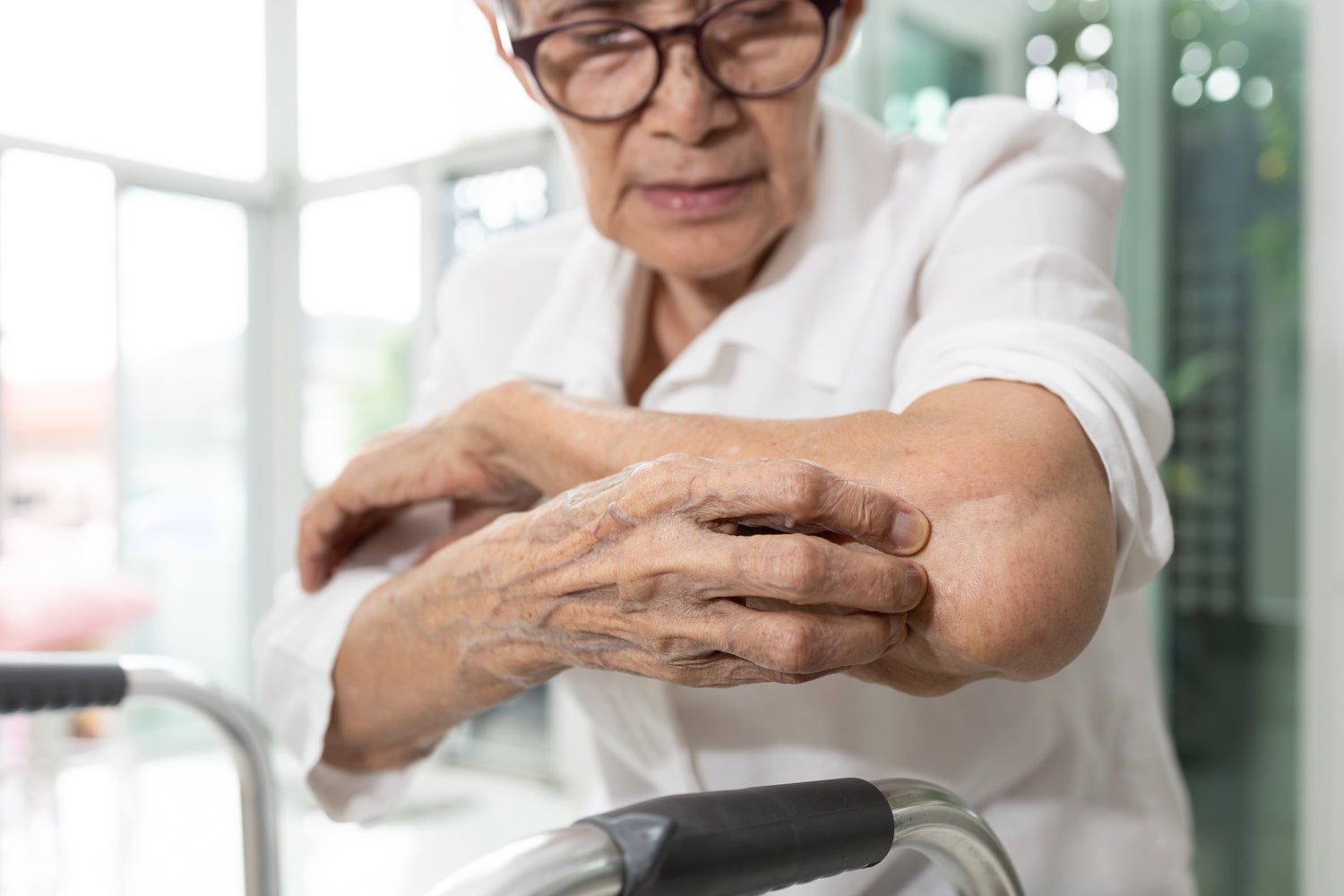Like every part of the body, our skin undergoes certain changes as we age. In teen years, annoying pimples wreak havoc on the face. Middle-aged adults often contend with the emergence of wrinkles and forehead lines. As for the elderly, a spectrum of skin conditions that range from minor irritations to major dermatological concerns may become increasingly apparent.
As time passes, our skin undergoes a remarkable transformation. It constantly renews itself, with new cells emerging from the skin's lower layers. However, as we age, this process of cell renewal begins to slow down.
Slower wound healing is a further effect of the aging skin process, which is also exacerbated by a sharp decline in skin cell turnover. In addition, aging impairs immunity, raising the risk of skin infections and resulting in age spots and sudden, obvious bruises.
While some skin issues, such as dark bruises, may be alarming but ultimately benign, others necessitate medical attention, especially when it comes to dealing with other skin conditions. As per the National Institute on Aging (NIA), the skin undergoes alterations as individuals age.
"It becomes thinner, loses fat, and no longer looks as plump and smooth as it once did. Your veins and bones can be seen more easily," the NIA, a branch of the U.S. National Institutes of Health tasked with comprehending the aging process and promoting extended periods of healthy and active living, said.
“Scratches, cuts, or bumps can take longer to heal. Years of suntanning or being out in the sunlight for a long time may lead to wrinkles, dryness, age spots, and even cancer,” it added.
WHAT ARE THE CAUSES?

Skin conditions in the elderly can be caused by a variety of factors, and they often result from a combination of age-related changes, environmental influences, and underlying health conditions. In an article published by WebMD, they explained that the skin ages depending on several factors, which include:
-
AGING
As people age, the production of collagen, a protein that provides skin with elasticity and firmness, decreases.
This can lead to wrinkles and sagging skin. Older adults also often have drier skin because the sebaceous glands produce less oil, making the skin more prone to dryness and itching. Aside from that, the epidermis, or the outer layer of skin, becomes thinner with age, making it more susceptible to damage and injury.
-
SUN EXPOSURE
Cumulative sun exposure over a lifetime can lead to skin damage, including sunburns, age spots, and an increased risk of skin cancer.
-
PRE-EXISTING CONDITIONS
Underlying health conditions like diabetes, autoimmune diseases, and vascular issues can affect skin health and increase the risk of skin problems.
-
DIET
Inadequate nutrition can impact the health and appearance of the skin. A diet lacking essential vitamins and minerals may lead to skin problems.
-
LIFESTYLE
Smoking and excessive alcohol consumption can contribute to skin aging and increase the risk of skin conditions.
-
GENETICS
Family history and genetics can play a role in determining an individual's susceptibility to certain skin conditions, such as skin cancer or hereditary skin disorders.
WHAT THE FIVE COMMON SKIN CONDITIONS?

Our skin ages and changes in a variety of ways depending on various factors. For a lifetime of healthy skin, it is essential to comprehend these changes. Here are the five common skin conditions in elderly adults.
1. ACTINIC KERATOSIS

Also known as solar keratosis or senile keratosis, actinic keratosis is a common precancerous skin condition that develops as a result of long-term exposure to ultraviolet (UV) radiation from the sun or artificial sources like tanning beds. It primarily affects fair-skinned individuals and is more prevalent in areas with high levels of sun exposure.
Actinic keratoses appear as dry, scaly, rough, and sometimes slightly raised patches or lesions on the skin. They are typically found on areas of the body that are frequently exposed to the sun, such as the face, ears, scalp, neck, backs of hands, forearms, or lips. These lesions may range in size from a few millimeters to a few centimeters and can vary in color from flesh-toned to reddish-brown.
2. SKIN CANCER

Skin cancer in elderly individuals, just as in people of any age, involves the formation of cancerous growths or tumors on the skin. While skin cancer can occur at any stage of life, it becomes increasingly prevalent as individuals age, primarily due to the accumulative impact of sun exposure over the years.
As people grow older, their skin's natural capacity to repair itself and defend against cancer becomes progressively reduced. Therefore, it is of utmost importance for elderly individuals to remain diligent in their efforts to prevent skin cancer, actively seek early detection, and undergo routine skin examinations. This becomes especially crucial if they have a history of extended periods of sun exposure.
3. SEBORRHEIC KERATOSIS

Also commonly known as "seborrheic warts" or "senile warts," seborrheic keratosis is a frequently occurring and typically benign skin condition characterized by the formation of non-cancerous growths on the skin. These growths often exhibit colors ranging from brown to black or tan, and they feature a surface that is waxy, scaly, or rough in texture. The size and appearance of seborrheic keratoses can vary, spanning from small, flat spots to larger, raised lesions.
4. XEROSIS

Xerosis, also known as dry skin, is a common dermatological condition characterized by the skin's lack of moisture or inability to retain sufficient moisture. It can affect people of all ages and is often a temporary and manageable condition. However, in some cases, it can be chronic and require ongoing care.
This condition is characterized by the skin's rough, scaly, or flaky texture, often accompanied by persistent itching, which can lead to considerable discomfort. In more severe instances, xerosis may result in skin redness and irritation, developing painful cracks and raising the risk of potential infections in the process.
5. ECZEMA

Eczema, or dermatitis, can affect individuals of all ages but may become more persistent or worsen in the elderly. In the U.S., more than 30 million Americans deal with the red, itchy, scaly symptoms of eczema. And while people put the focus on treating the symptoms that eczema brings, this inflammatory skin condition is more than just its rash-like appearance.
Eczema, also known as atopic dermatitis, is a group of conditions that cause the skin on any part of the body to become irritatingly itchy, red, and dry. The typical symptoms of eczema include itching, redness, dryness, rash, swelling, crusting, thickened skin, and discomfort.
To learn more about eczema, you may read: 7 Types of Eczema
HOW TO KEEP THE SKIN HEALTHY

Maintaining healthy skin, even for elderly adults, is crucial. It does not only protect the body against infections and pressure sores, but also enhances comfort, mobility, and quality of life. Here are some tips from the NIA to keep your skin healthy:
- LIMIT TIME IN THE SUN
It’s okay to go out during the day, but try to avoid being in the sun during peak times when the sun’s rays are strongest. For example, during the summer, try to stay out of the sun between 10 a.m. and 4 p.m. Don’t be fooled by cloudy skies. The sun’s rays can go through clouds. You can also get sunburned if you are in water, so be careful when you are in a pool, a lake, or the ocean.
- USE SUNSCREEN
Look for a sunscreen with an SPF number of 15 or higher. It’s best to choose sunscreens with “broad spectrum” on the label. Put the sunscreen on 15 to 30 minutes before you go outside. Sunscreen should be reapplied at least every two hours. You need to put sunscreen on more often if you are swimming, sweating, or rubbing your skin with a towel.
- APPLY MOISTURIZERS
According to The Dermatology Office, the loss of moisture in your skin can begin as early as the age of 40.
"For this reason, it is important that early on, you start to take steps to moisturize your skin," it said.
"Dermatologists often recommend that older individuals apply moisturizer to their aging skin about three minutes after they take a shower or after they take a bath," it added, stressing that they should apply moisturizer to their skin more than once a day.
- AVOID TANNING
Don’t use sunlamps or tanning beds. Tanning pills are not approved by the U.S. Food and Drug Administration and might not be safe.
- WEAR PROTECTIVE CLOTHING
A hat with a wide brim can shade your neck, ears, eyes, and head. Look for sunglasses that block 99% to 100% of the sun’s rays. If you have to be in the sun, wear loose, lightweight, long-sleeved shirts and long pants or long skirts.
- CHOOSE ORGANIC COTTON CLOTHING
In addition to these tips, the clothes that you wear play a multifaceted role in maintaining healthy skin by offering protection from environmental factors, reducing the risk of skin damage, and promoting comfort.
Choosing appropriate clothing for different weather conditions and activities is an essential aspect of skincare and overall well-being. They are, after all, your best defense against external factors, so always wear lightweight and loose garments that can be easily removed or added as the temperature changes.
The NEA even encourages people to wear clothing made of natural fabric like cotton that is not too tight or close to the skin. If you’re having a hard time looking for clothes that won’t irritate your skin and help protect your skin from the sun, try our allergy-free clothes, made from 100% chemical-free and organic cotton, which are ultimately breathable and comfortable.
If you are seeking clothing options that prioritize safety for individuals with skin allergies and sensitivities, explore our allergy-free organic cotton collection. These garments provide a comfortable and synthetics-free experience, allowing individuals to live with ease while maintaining skin health.
TAKEAWAY: Skin conditions become more apparent in elderly adults due to a combination of intrinsic factors related to the aging process and other lifestyle choices. Thus, it's essential for elderly individuals to prioritize skin health and seek timely medical attention for any concerning conditions.
DISCLAIMER: The information presented on Cottonique is not, and will never be, intended to be a substitute for professional medical advice, diagnosis, or treatment. All content materials found on this site, from text, treatments, outcomes, charts, graphics, photographs, and study findings, are created and published for general informational purposes only. It should not, in any way, be construed as a standard of care to be followed by a user of the website.
Thus, readers are encouraged to verify any information obtained from this website with other accurate references and review all information regarding any medical condition or treatment with their physician. As Cottonique strives to help those with allergies live with better days, the hypoallergenic apparel brand encourages everyone to always seek the advice of their physician or other qualified health providers with any questions they may have regarding a medical condition.




Laisser un commentaire
Tous les commentaires sont modérés avant d'être publiés.
Ce site est protégé par reCAPTCHA, et la Politique de confidentialité et les Conditions d'utilisation de Google s'appliquent.